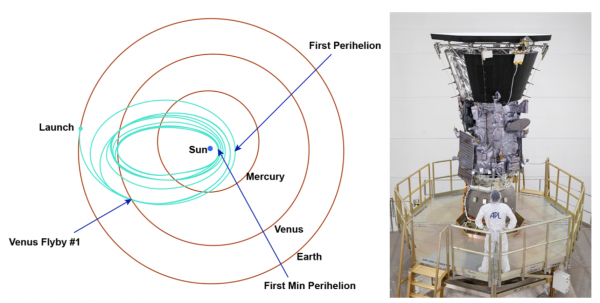2019年BAAO第1题-帕克太阳探测器
英文题目
Qu 1. Parker Solar Probe
The Parker Solar Probe (PSP) is part of a mission to learn more about the Sun, named after the scientist that first proposed the existence of the solar wind, and was launched on 12th August 2018. Over the course of the 7 year mission it will orbit the Sun 24 times, and through 7 flybys of Venus it will lose some energy in order to get into an ever tighter orbit (see Figure 1). In its final 3 orbits it will have a perihelion (closest approach to the Sun) of only $$r_{peri} = 9.86 R_{⊙}$$, about 7 times closer than any previous probe, the first of which is due on 24th December 2024. In this extreme environment the probe will not only face extreme brightness and temperatures but also will break the record for the fastest ever spacecraft.
Figure 1: Left: The journey PSP will take to get from the Earth to the final orbit around the Sun. Right: The probe just after assembly in the John Hopkins University Applied Physics Laboratory. Credit: NASA / John Hopkins APL / Ed Whitman.
a. When the probe is at its closest perihelion:
(i) Calculate the apparent magnitude of the Sun, given that from Earth $$m_{⊙} = −26.74$$.
(ii) Calculate the temperature the heat shield must be able to survive. Assume that the heat shield of the probe absorbs all of the incident radiation, radiates as a perfect black body, and that only one side of the probe ever faces the Sun (to protect the instruments) such that the emitting (surface) area is double the absorbing (cross-sectional) area.
b. The speed, $$v$$, of an object in an elliptical orbit of semi-major axis $$a$$ around an object of mass $$M$$ when a distance $$r$$ away can be calculated as
$$v^2=GM(\frac{2}{r}-\frac{1}{a})$$.
Given that in its final orbit PSP has a orbital period of 88 days, calculate the speed of the probe as it passes through the minimum perihelion. Give your answer in km s−1.

